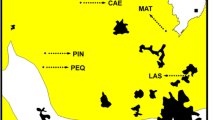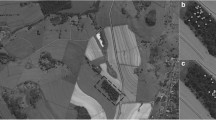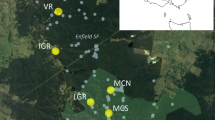Abstract
Roupala montana var. brasiliensis is a timber tree species native to the Cerrado and Atlantic Forest areas of Brazil. The wood was exploited for international markets, but there is no information on the conservation status of its natural populations, nor on other key aspects, such as mating system, gene flow, and inbreeding depression, essential for the species’ sustainable management and conservation. We report the first study of any Roupala species to apply a validated set of species-specific microsatellite markers to genotype adults, juveniles, and seedlings, and analyse genetic diversity, inbreeding, effective population size, and mating system. We studied four populations of the species in areas of mixed Ombrophilous forest with different disturbance levels (undisturbed to strongly disturbed) in southern Brazil. The species occurs at low frequency in the study forests, but the populations are genetically diverse without significant differences in genetic diversity levels related to disturbance. The study also indicated resistance to the severe fragmentation associated with low density of individuals, with a stable mating system showing preferential outcrossing, with some inbreeding (tm ≈ 0.83, F > 0.165). Despite being spatially isolated from each other, the populations are not reproductively isolated, receiving immigrant pollen from long distances, although there was no evidence of gene flow into the populations via seeds. Seedlings from self-fertilization show low levels of inbreeding depression, which may reflect earlier pre-germination selection events. There was loss of allelic wealth in the younger cohorts, which may be a warning of the fragility of the genetic diversity detected in populations. We consider the implications of the results for the development of ex and in situ conservation and tree improvement programs.






Similar content being viewed by others
Data availability
Data Archiving Statement: Genotype and phenotype data have been submitted to the Figshare Digital Repository (https://doi.org/10.6084/m9.figshare.22897613).
References
Aguiar BI, Gandara FB, Freitas MLM, Moraes MLT, Kageyama PY, Sebbenn AM (2019) Validation of microsatellite loci for Balfourodendron riedelianum through analysis of Mendelian inheritance, genetic linkage, and genotypic linkage disequilibrium. Silvae Genet 60:81–84. https://doi.org/10.2478/sg-2019-0015
Aguiar BI, Freitas MLM, Zannato AS, Tambarussi EV, Moraes MT, Ambrosano MN, Pereira LCSM, Gandara FB, Kageyama PY, Sebbenn AM (2020) The effects of pollen dispersal and mating pattern on inbreeding depression and hybrid vigor in Balfourodendron riedelianum (Engl.) Engl. (Rutaceae). Conserv Genet 21:305–317. https://doi.org/10.1007/s10592-020-01250-0
Angbonda DMA, Monthe FK, Bourland N, Boyemba F, Hardy OJ (2021) Seed and pollen dispersal and fine-scale spatial genetic structure of a threatened tree species: Pericopsis elata (HARMS) Meeuwen (Fabaceae). Tree Genet Genomes 17:27. https://doi.org/10.1007/s11295-021-01509-8
Aparecido LEO, Rolim GS, Richetti J, Souza PS, Johann JA (2016) Köppen, thornthwaite and camargo climate classifications for climatic zoning in the state of Paraná, Brazil. Ciên Agrotecn 40:405–417. https://doi.org/10.1590/1413-70542016404003916
Austerlitz F, Smouse PE (2001) Two-generation analysis of pollen flow across a landscape. II. Relation between Φft, pollen dispersal and interfemale distance. Genetics 157:851–857. https://doi.org/10.1111/j.0014-3820.2001.tb01291.x
Bacles CF, Lowe AJ, Ennos RA (2006) Effective seed dispersal across a fragmented landscape. Science 311:628. https://doi.org/10.1126/science.1121543
Browne L, Karubian J (2018) Habitat loss and fragmentation reduce effective gene flow by disrupting seed dispersal in a neotropical palm. Mol Ecol 27:3055–3069. https://doi.org/10.1111/mec.14765
Caballero A, Bravo I, Wang J (2017) Inbreeding load and purging: implications for the short-term survival and the conservation management of small populations. Heredity 118:177–185. https://doi.org/10.1038/hdy.2016.80
Campos Filho EM, Sartorelli PAR (2015) Guia de identificação de espécies-chave para a restauração florestal na Região do Alto Teles Pires, Mato Grosso. The Nature Conservancy, São Paulo. https://www.nature.org/media/brasil/guia-mt.pdf
Carvalho CS, Lanes ECM, Silva AR, Caldeira CF, Carvalho-Filho N, Gastauer M, Imperatriz-Fonseca VL, Júnior WN, Oliveira G, Siqueira JO, Viana PL, Jaffé R (2019) Habitat loss does not always entail negative genetic consequences. Front Genet 10:1011. https://doi.org/10.3389/fgene.2019.01101
Carvell C, Jordan WC, Bourke AFG, Pickles R, Redhead JW, Heard MS (2012) Molecular and spatial analyses reveal links between colony-specific foraging distance and landscape-level resource availability in two bumblebee species. Oikos 121:734–742. https://www.jstor.org/stable/41489298
Charlesworth B, Charlesworth D (1999) The genetic basis of inbreeding depression. Genet Res 74(3):329–340. https://doi.org/10.1017/s0016672399004152
Chen X-Y, Fan X-X, Hu X-S (2008) Roles of seed and pollen dispersal in natural regeneration of Castanopsis fargesii (Fagaceae): Implications for forest management. For Ecol Manag 256:1143–1150. https://doi.org/10.1016/j.foreco.2008.06.014
Chybicki IJ, Burczyk J (2009) Simultaneous estimation of null alleles and inbreeding coefficients. Heredity 100:106–113. https://doi.org/10.1093/jhered/esn088
Chybicki IJ, Oleksa A (2018) Seed and pollen gene dispersal in Taxus baccata, a dioecious conifer in the face of strong population fragmentation. Ann Bot 122:409–421. https://doi.org/10.1093/aob/mcy081
Collins BG, Rebelo T (1987) Pollination biology of the Proteaceae in Australia and Southern Africa. Aust J Ecol 12:387–421. https://doi.org/10.1111/j.1442-9993.1987.tb00958.x
Cubas R (2011) Florística, estrutura e dinâmica em uma Floresta Ombrófila Mista no norte do Estado de Santa Catarina. Master thesis (Forest Sciences), Universidade do Centro-Oeste do Paraná
De Cauwer I, Vernet P, Billiard S, Godé C, Bourceaux A, Ponitzki C, Saumitou‐Laprade P (2020) Widespread coexistence of self‐compatible and self‐incompatible phenotypes in a diallelic self‐incompatibility system in Ligustrum vulgare (Oleaceae). bioRxiv. https://doi.org/10.1101/2020.03.26.009399
Degen B, Sebbenn AM (2014) Genetics and tropical forests. In: Köhl M, Pancel L (eds) Tropical forestry handbook. Springer, Berlin, pp 1–30. https://doi.org/10.1007/978-3-642-41554-8_75-1
Dow BD, Ashley MV (1996) Microsatellite analysis of seed dispersal and parentage of saplings in bur oak, Quercus macrocarpa. Mol Ecol 5:615–627. https://doi.org/10.1111/j.1365-294X.1996.tb00357.x
El Mousadik A, Petit RJ (1996) High level of genetic differentiation for allelic richness among populations of the argan tree Argania spinosa (L.) Skeels endemic to Morocco. Theor Appl Genet 92:832–839. https://doi.org/10.1007/bf00221895
Faleiro FG, Faleiro ASG, Cordeiro MCR, Karia CT (2003) Metodologia para operacionalizar a extração de DNA de espécies nativas do Cerrado visando análises moleculares. Comunicado Técnico, 92. Planaltina: EMBRAPA Cerrados. https://ainfo.cnptia.embrapa.br/digital/bitstream/CPAC-2009/24559/1/comtec_92.pdf
Ferrer MM, Good SV (2012) Self-sterility in flowering plants: preventing self-fertilization increases family diversification rates. Ann Bot 110:535–553. https://doi.org/10.1093/aob/mcs124
Forti G, Tambarussi EV, Kageyama PY, Moreno MA, Ferraz EM, Ibanes B, Mori GM, Vencovsky R, Sebbenn AM (2014) Low genetic diversity and intrapopulation spatial genetic structure of the Atlantic Forest tree, Esenbeckia leiocarpa Engl. (Rutaceae). Ann For Res 57:165–174. https://doi.org/10.15287/afr.2014.226
Fuchs EJ, Hamrick JL (2011) Mating system and pollen flow between remnant populations of the endangered tropical tree, Guaiacum sanctum (Zygophyllaceae). Conserv Genet 12:175–185. https://doi.org/10.1007/s10592-010-0130-8
Fuchs E, Lobo J, Quesada M (2003) Effects of forest fragmentation and flowering phenology on the reproductive success and mating patterns of the tropical dry forest tree Pachira quinata. Conserv Biol 17:149–157. https://www.jstor.org/stable/3095281
Gentleman RC, Carey VJ, Bates DM et al (2004) Bioconductor: open software development for computational biology and bioinformatics. Genome Biol 5:R80. https://doi.org/10.1186/gb-2004-5-10-r80
Gibbs PE (2014) Late-acting self-incompatibility—the pariah breeding system in flowering plants. New Phytol 203:717–734. https://doi.org/10.1111/nph.12874
Gillet E, Hattemer HH (1989) Genetic analysis of isoenzyme phenotypes using single tree progenies. Heredity 63:135–141. https://doi.org/10.1038/hdy.1989.84
Goodwillie C, Kalisz S, Eckert CG (2005) The evolutionary enigma of mixed mating systems in plants: occurrence, theoretical explanations, and empirical evidence. Ann Rev Ecol Evol Syst 36:47–79. https://doi.org/10.1146/annurev.ecolsys.36.091704.175539
Goudet J (2002) Fstat version (1.2) a computer program to calculate F-statistics. J Hered 86:485–486. https://doi.org/10.1093/oxfordjournals.jhered.a111627
Hardy O, Vekemans X (2002) SPAGeDI: a Versatile computer program to analyze spatialg genetic structure at the individual or population levels. Mol Ecol Notes 2:618–620. https://doi.org/10.1046/j.1471-8286.2002.00305.x
Hedrick F (2005) A standardized genetic differentiation measure. Evolution 59:1633–1638. https://doi.org/10.1111/j.0014-3820.2005.tb01814
Hufford KM, Hamrick JL (2003) Viability selection at three early life stages of the tropical tree, Platypodium elegans (Fabaceae, Papilionoideae). Evolution 57:518–526. https://doi.org/10.1111/j.0014-3820.2003.tb01543.x
Isabel N, Holliday JA, Aitken SN (2020) Forest Genomics: advancing climate adaptation, forest health, productivity, and conservation. Evol Appl 13:3–10. https://doi.org/10.1111/eva.12902
Ismail CA, Ghazoul J, Ravikanth G, Kushalappa CG, Shaanker RU, Kettle CJ (2017) Evaluating realized seed dispersal across fragmented tropical landscapes: a two-fold approach using parentage analysis and the neighbourhood model. New Phytol 214:1307–1316. https://doi.org/10.1111/nph.14427
Kalinowski ST, Taper ML, Marshall TC (2007) Revising how the computer program CERVUS accommodates genotyping error increases success in paternity assignment. Mol Ecol 16:1099–1106. https://doi.org/10.1111/j.1365-294X.2007.03089.x
Kubota TYK, Silva AM, Cambuim J, Silva AA, Pupin S, Silva MS, Moraes MA, Moraes MLT, Sebbenn AM (2017) Mendelian inheritance, genetic linkage, and genotypic disequilibrium for nine microsatellite loci in Cariniana estrellensis (Raddi) Kuntze (Lecythidaceae). Genet Mol Res 16:gmr16029653. https://doi.org/10.4238/gmr16029653
Lacerda AEB, Nimmo ER, Sebbenn AM (2013) Modeling the long-term impacts of logging on genetic diversity and demography of Hymenaea courbaril. For Sci 59:15–26. https://doi.org/10.5849/forsci.10-118
Leal JB, Santos RP, Gaiotto FA (2014) Effect of selective logging on genetic diversity and gene flow in Cariniana legalis sampled from a cacao agroforestry system. Genet Mol Res 13:626–635. https://doi.org/10.4238/2014.January.28.8
Levin DA (1988) The paternity pool of plants. Am Nat 132:309–317
Lindgren D, Luigi DG, Jefferson PA (1997) Status number for measuring genetic diversity. For Genet 4:69–76
Loiselle BA, Sork VL, Nason J, Graham C (1995) Spatial genetic structure of a tropical understory shrub, Psychotria officinalis (Rubiaceae). Am J Bot 82:1420–1425. https://doi.org/10.2307/2445869
Lorenzi H (2008) Árvores brasileiras: Manual de identificação e cultivo de plantas arbóreas nativas do Brasil, 3rd edn. Plantarum, São Paulo
Lowe AJ, Cavers S, Boshier D, Breed MF, Hollingsworth PM (2015) The resilience of forest fragmentation genetics—no longer a paradox—we were just looking in the wrong place. Heredity 115:97–99. https://doi.org/10.1038/hdy.2015.86
Medina Breed M, Ottwell K, Gardener M, Marklund MHK, Stead MG, Harris JBC, Lowe AJ (2015) Mating system and early viability resistance to habitat fragmentation in a bird-pollinated Eucalypt. Heredity 115:100–107. https://doi.org/10.1038/hdy.2012.72
Murawski DA, Hamrick JL (1992) The mating system of Cavanillesia platanifolia under extremes of flowering-tree density—a test of predictions. Biotropica 24:99–101. https://doi.org/10.2307/2388478
Nei M (1987) Molecular evolutionary genetics. Columbia University Press, New York, p 512
Oliveira PE, Gibbs PE (2000) Reproductive biology of woody plants in a Cerrado community of central Brazil. Flora 195:311–329. https://doi.org/10.1016/S0367-2530(17)30990-8
Oliveira SS, Campos T, Sebbenn AM, D’Oliveira MVN (2020) Using spatial genetic structure of a population of Swietenia macrophylla King to integrate genetic diversity into management strategies in Southwestern Amazon. For Ecol Manag 464:118040. https://doi.org/10.1016/j.foreco.2020.118040
Parejo-Farnés C, Robledo-Arnuncio JJ, Albaladejo RG, Rubio-Pérez E, Aparicio A (2017) Effects of habitat fragmentation on parental correlations in the seed rain of a bird-dispersed species. Tree Genet Genomes 13:17. https://doi.org/10.1007/s11295-017-1100-9
Pereira FB, Sebbenn AM, Rossini BC, Melchert GF, Marino CLM, Ribolla PEM, Alonso DP, Silva EJV, Tambarussi EV (2021) Isolation of 27 polymorphic nuclear microsatellite markers for Roupala montana var. brasiliensis (Proteaceae). Ann Acad Bras Ciênc 93:e20200452. https://doi.org/10.1590/0001-3765202120200452
Pereira LCSM, Tambarussi EV, Biliati MO, Martins K, Kageyama PY, Sebbenn AM (2020) Inbreeding depression from selfing and mating among relatives of Hymenaea courbaril L. For Ecol Manag 475:118414. https://doi.org/10.1016/j.foreco.2020.118414
Peres EA, Pinto-da-Rocha R, Lohmann LG, Michalangeli FA, Miyaki CY, Carnaval AC (2020) Patterns of species and lineage diversity in the Atlantic Rainforest of Brazil. In: Rull V, Carnaval AC (eds) Neotropical diversification: patterns and processes. Springer, Berlin, pp 441–448
Prance G, Plana V, Edwards KS, Pennington R (2007) Proteaceae. Flora Neot 100:211–218. https://doi.org/10.3897/phytokeys.13.2836
Pupin S, Sebbenn AM, Cambuim J, Silva AM, Zaruma DUG, Silva PHM, Rosse LN, Souza ICG, Marino CL, Moraes MLT (2019) Effects of pollen contamination and non-random mating on inbreeding and outbreeding depression in a seedling seed orchard of Eucalyptus urophylla S.T. Blake. For Ecol Manag 437:272–281. https://doi.org/10.1016/j.foreco.2019.01.050
Puttker T, Crouzeilles R, Almeida-Gomes M, Schmoeller M, Maurenza D, Alves-Pinto H et al (2020) Indirect effects of habitat loss via habitat fragmentation: a cross-taxa analysis of forest-dependent species. Biol Conserv 241:108368. https://doi.org/10.1016/j.biocon.2019.108368
Raimúndez-Urrutia E (2008) Abortion and predispersal seed predation in the American Proteaceae Roupala montana Aubl. Caribb J Sci 44:164–174. https://doi.org/10.18475/cjos.v44i2.a5
Ribeiro MC, Metzger JP, Martensen AC, Ponzoni FJ, Hirato MM (2009) The Brazilian Atlantic Forest: how much is left, and how is the remaining forest distributed? Implications for conservation. Biol Conserv 142:1141–1153. https://doi.org/10.1016/j.biocon.2009.02.021
Ritland K (2002) Extensions of modelsfor the estimation of mating systems using n independent loci. Heredity 88:221–228. https://doi.org/10.1038/sj.hdy.6800029
Rohwäder MS, Jeltsch F (2022) Foraging personalities modify effects of habitat fragmentation on biodiversity. Oikos e09056. https://doi.org/10.1111/oik.09056
Sandler G, Wright SI, Agrawal AF (2021) Patterns and causes of signed linkage disequilibria in flies and plants. Mol Biol Evol 38:4310–4321. https://doi.org/10.1093/molbev/msab169
Sebbenn AM (2006) Sistema de reprodução em espécies tropicais e suas implicações para a seleção de arvores matrizes para reflorestamentos ambientais. In: Silva LD, Higa AR (eds) Pomar de Espécies Florestais Nativas, 1st edn. FUPEF, Curitiba, pp 93–138
Sebbenn AM, Carvalho ACM, Freitas MLM, Moraes SMB, Gaino APSC, Silva GM, Jolivet C, Moraes MLT (2011) Low levels of realized seed and pollen gene flow and strong spatial genetic structure in a small, isolated and fragmented population of the tropical tree Copaifera langsdorffii Desf. Heredity 106:134–145. https://doi.org/10.1038/hdy.2010.33
Sokal RR, Rohlf FJ (1995) Biometry: the principles and practice of statistics in biological research. W. H. Freeman, New York
Stacklies W, Redestig H, Scholz M, Walther D, Selbig J (2007) pcaMethods—a Bioconductor package providing PCA methods for incomplete data. Bioinformatics 23:1164–1167. https://doi.org/10.1093/bioinformatics/btm069
Steffan-Dewenter I, Westphal C (2008) The interplay of pollinator diversity, pollination services and landscape change. J Appl Ecol 45:737–741. https://doi.org/10.1111/j.1365-2664.2008.01483.x
Tambarussi EV, Boshier D, Vencovsky R, Freitas MLM, Di-Dio OJ, Sebbenn AM (2015) Paternity analysis reveals significant isolation and near neighbour pollen dispersal in small Cariniana legalis Mart. Kuntze populations in the Brazilian Atlantic Forest. Ecol Evol 5:55885600. https://doi.org/10.1002/ece3.1816
Tambarussi EV, Boshier D, Vencovsky R, Freitas MLM, Sebbenn AM (2017) Inbreeding depression from selfing and mating between relatives in the Neotropical tree Cariniana legalis Mart. Kuntze. Conserv Genet 18:225–234. https://doi.org/10.1007/s10592-016-0896-4
Wang JL, Hill WG, Charlesworth D, Charlesworth B (1999) Dynamics of inbreeding depression due to deleterious mutations in small populations: mutation parameters and inbreeding rate. Genet Res 74:165–178. https://doi.org/10.1017/s0016672399003900
World Timbers Inc. (2019) Wood Database and Searchable Library: Roupala brasiliensis. https://www.woodworkerssource.com/online_show_wood.php?wood=Roupala%20brasiliensis.
Acknowledgements
This study is part of the PhD dissertation of first author. We also thank Tiago Grespan, Isabel Homczinski and Guilherme F. Melchert for supporting the field work. The authors are grateful to the Conselho Nacional de Desenvolvimento Científico e Tecnológico (CNPq, Universal 402420/2016-0) for financial support for this research. The study was financed in part by the Coordenação de Aperfeiçoamento de Pessoal de Nível Superior – Brasil (CAPES) – Finance Code 001. AMS (Grant No. 304650/2020-0) and EVT (Grant No. 304899/2019-4) are supported by CNPq research fellowships.
Funding
The reported research received funding from Conselho Nacional de Desenvolvimento Científico e Tecnológico (CNPq), under Grant Agreement number 402420/2016-0. The study was financed in part by the Coordenação de Aperfeiçoamento de Pessoal de Nível Superior – Brasil (CAPES) – Finance Code 001.). Evandro V. Tambarussi, Alexandre M. Sebbenn and Edson Vidal were supported by research productivity fellowships granted by CNPq.
Author information
Authors and Affiliations
Contributions
Fernanda Bortolanza Pereira contributed to all stages by, designing the study, sampling the populations, laboratory analyses, statistical analysis of the data, and writing the manuscript. Alexandre M. Sebbenn contributed to the methodology, statistical analysis of the data, and writing the manuscript. Bruno C. Rossini contributed to the laboratory work and analyses and collaborated on writing the manuscript. David H. Boshier contributed with the design of the study and collaborated on writing the manuscript. Celso L. Marino, Miguel L.M. Freitas and Edson Vidal collaborated with manuscript writing, João R. B. F. Rosa Contributed to statistical analysis. Evandro V. Tambarussi conceived and coordinated the project, supervised the first author, acquired funding for the study, participated in the analyses, and edited the manuscript for submission. All authors read and revised the final manuscript.
Corresponding author
Ethics declarations
Conflict of interest
The authors declare that they have no financial or non-financial to disclose.
Additional information
Publisher's Note
Springer Nature remains neutral with regard to jurisdictional claims in published maps and institutional affiliations.
Supplementary Information
Below is the link to the electronic supplementary material.
Rights and permissions
Springer Nature or its licensor (e.g. a society or other partner) holds exclusive rights to this article under a publishing agreement with the author(s) or other rightsholder(s); author self-archiving of the accepted manuscript version of this article is solely governed by the terms of such publishing agreement and applicable law.
About this article
Cite this article
Pereira, F.B., Sebbenn, A.M., Boshier, D.H. et al. Gene flow, mating patterns and inbreeding depression in Roupala montana var. brasiliensis, a neotropical timber species. New Forests (2023). https://doi.org/10.1007/s11056-023-10009-7
Received:
Accepted:
Published:
DOI: https://doi.org/10.1007/s11056-023-10009-7




